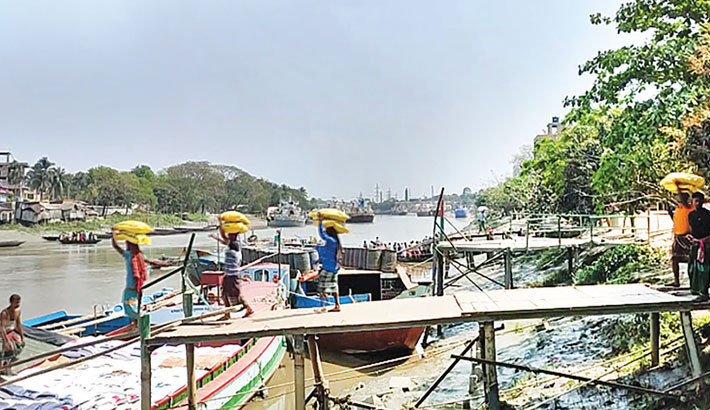Imports through Noapara River Port double despite navigability crisis
Unskilled vessel masters anchor outside the main channel near the riverbanks
Tanjer Mohsin, Benapole
Published: 19 Oct 2025

Despite growing navigability problems and frequent vessel sinkings, imports through the Noapara River Port in Jashore’s Abhaynagar upazila have doubled in the 2024-25 fiscal year compared to the previous year.
According to port sources, 2,519 vessels transported 1,511,843 tonnes of goods through the port during the fiscal year, generating Tk3.30 crore in government revenue.
In 2023-24, the port handled 1,613 vessels carrying 706,813 tonnes of goods, earning Tk2.65 crore.
In earlier years, the numbers were: 1,584 vessels in 2022-23 (692,313 tonnes), 1,375 in 2021-22 (590,220 tonnes), and 1,205 in 2020-21 (538,920 tonnes).
However, this growing trade volume comes amid worsening navigability in the Bhairab River, which flows through Noapara – the country’s largest and busiest river port in the southwest. Over the past 18 months, more than 15 cargo vessels have sunk there.
Vessel owners, workers, and port officials identified four key causes behind the recurring accidents, which include lack of regular dredging, encroachment, unskilled masters, and poor maintenance.
Lack of regular dredging has severely reduced navigability in the Bhairab River. Dredging is done unevenly, deep in some areas, untouched in others. Encroachment is gradually narrowing the river.
Unskilled vessel masters anchor outside the main channel near the riverbanks. Due to poor maintenance, aging vessels often crack and sink under heavy loads.
The port stretches 20 kilometers from Mujtakhali to Afraghat. On 9 February this year, the cargo vessel MV Seven Seas-4, carrying 850 tonnes of urea fertiliser, sank near Shubharara after its hull ruptured.
Other recent incidents include the sinking of MV Sakib Vibha-2 (coal worth Tk1.10 crore) at Nona Ghat on 13 April last year, MV Western-2 (700 tonnes of wheat) at Siddipasha on 25 January, MV R Razzak (820 tonnes of coal) on 15 December, MV Purboanchal-7 (800 tonnes of coal) on 15 January, and MV Moumoni-1 (700 tonnes of coal) on 13 January.
Vessel workers said that while the number of ships has increased, anchoring space is shrinking and low water levels often make navigation perilous. Locals have long demanded regular dredging and the construction of safe jetties.
“Noapara is the largest river-based economic hub in the southwest, but its condition has long been deteriorating,” said Chowdhury Minhaj Uz Zaman Sajal, treasurer of the Khulna River Transport Owners’ Association. “The river is shrinking as water levels drop. We’ve repeatedly called for proper dredging, but no effective steps have been taken.”
Niamul Islam Riko, member secretary of the Noapara branch of the Bangladesh Water Transport Workers Federation, said, “Navigability in the Bhairab River is in a dire state. Due to encroachment and uneven dredging, ships are sinking frequently.”
Aditya Majumder, an importer of fertiliser and food grains, added, “We’re facing serious problems. Imports have doubled, but there’s been no infrastructural improvement. We even have to build our own temporary docks.”
Similarly, Shah Jalal Hossain, general secretary of the Noapara Fertiliser and Food Grain Traders’ Association, said, “Noapara’s economy depends on the Bhairab River, but the port has seen no development. Even small vessels can’t dock properly. We demanded a guide wall, but it hasn’t been built.”
Masud Parvez, deputy director of Noapara River Port, said, “There is a navigability crisis in almost all rivers, including the Bhairab, and dredging is underway.”
“Most accidents happen because unskilled masters anchor outside the main channel and old vessels are not repaired regularly,” he said.
Parvez added that several development projects are underway to upgrade the port.
“The government has taken multiple initiatives, including installing permanent boundary pillars. Once implemented, more vessels will be able to anchor here. Despite the challenges, both cargo handling and revenue collection continue to rise every year.”

